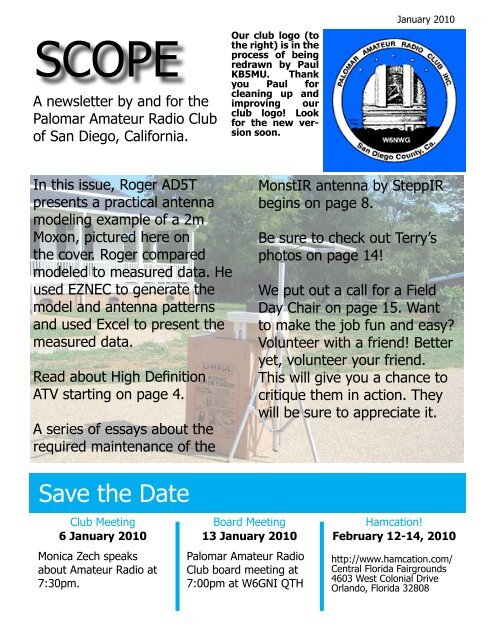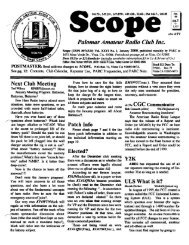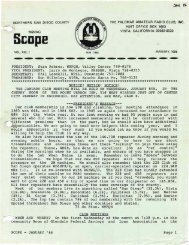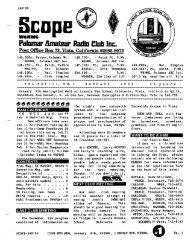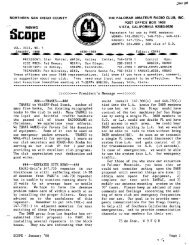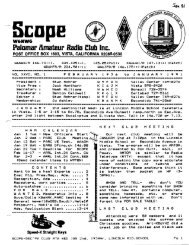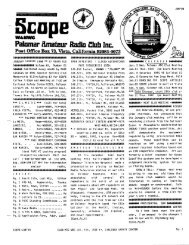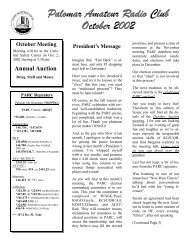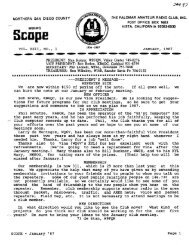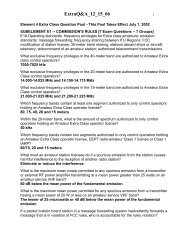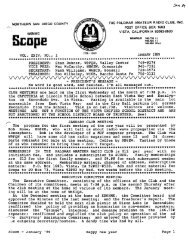Jan - Palomar Amateur Radio Club
Jan - Palomar Amateur Radio Club
Jan - Palomar Amateur Radio Club
You also want an ePaper? Increase the reach of your titles
YUMPU automatically turns print PDFs into web optimized ePapers that Google loves.
SCOPE<br />
A newsletter by and for the<br />
<strong>Palomar</strong> <strong>Amateur</strong> <strong>Radio</strong> <strong>Club</strong><br />
of San Diego, California.<br />
Our club logo (to<br />
the right) is in the<br />
process of being<br />
redrawn by Paul<br />
KB5MU. Thank<br />
you Paul for<br />
cleaning up and<br />
improving our<br />
club logo! Look<br />
for the new version<br />
soon.<br />
<strong>Jan</strong>uary 2010<br />
In this issue, Roger AD5T<br />
presents a practical antenna<br />
modeling example of a 2m<br />
Moxon, pictured here on<br />
the cover. Roger compared<br />
modeled to measured data. He<br />
used EZNEC to generate the<br />
model and antenna patterns<br />
and used Excel to present the<br />
measured data.<br />
Read about High Definition<br />
ATV starting on page 4.<br />
A series of essays about the<br />
required maintenance of the<br />
MonstIR antenna by SteppIR<br />
begins on page 8.<br />
Be sure to check out Terry’s<br />
photos on page 14!<br />
We put out a call for a Field<br />
Day Chair on page 15. Want<br />
to make the job fun and easy?<br />
Volunteer with a friend! Better<br />
yet, volunteer your friend.<br />
This will give you a chance to<br />
critique them in action. They<br />
will be sure to appreciate it.<br />
Save the Date<br />
<strong>Club</strong> Meeting<br />
Board Meeting<br />
Hamcation!<br />
6 <strong>Jan</strong>uary 2010 13 <strong>Jan</strong>uary 2010 February 12-14, 2010<br />
Monica Zech speaks<br />
about <strong>Amateur</strong> <strong>Radio</strong> at<br />
7:30pm.<br />
<strong>Palomar</strong> <strong>Amateur</strong> <strong>Radio</strong><br />
<strong>Club</strong> board meeting at<br />
7:00pm at W6GNI QTH<br />
http://www.hamcation.com/<br />
Central Florida Fairgrounds<br />
4603 West Colonial Drive<br />
Orlando, Florida 32808
Classified Ads are Free for Members!<br />
HAM<br />
RADIO<br />
H<br />
R<br />
O<br />
Jose XE2SJB<br />
Jerry N5MCJ<br />
OUTLET<br />
KENWOOD<br />
rf CONCEPTS<br />
DIAMOND<br />
US TOWERS<br />
KANTRONICS<br />
YAESU, MFJ, ICOM<br />
BENCHER, Inc.<br />
HUSTLER<br />
COMET<br />
AMERITRON<br />
Astron,<br />
AEA,<br />
OUTBACKER<br />
Larsen Antennas<br />
TEN-TEC<br />
Hy-gain, Tri-EX,<br />
Cushcraft And Others<br />
too<br />
Numerous to<br />
Mention!<br />
Drop in to see our display<br />
of working equipment.<br />
Find out about Pkt location<br />
determining equipment<br />
(APRS). Check our<br />
complete line of<br />
magazines, ARRL books,<br />
license manuals, and<br />
Bulletin Board with all<br />
sorts of Goodies listed.<br />
Open: 10a.m. – 5:30p.m.<br />
Monday thru Saturday<br />
858 560-4900<br />
or toll free 1-800-854-6046<br />
Ask about our<br />
great prices<br />
Directions: On 163, take Clairemont Mesa Blvd. off ramp to East. Stay in<br />
right-hand lane. Turn right at stoplight. As you are turning right you can see<br />
our beams in this shopping center. Travel 100 yds. On Kearny Villa Rd. and<br />
U-turn back to shopping area and HRO sign. Be sure to see our equipment in<br />
action on real antennas!<br />
<strong>Club</strong> Reports<br />
Membership<br />
Three members reinstated their<br />
membership. Welcome back.<br />
If the Post Office returns your<br />
SCOPE, and we have an e-mail<br />
address, we can often find out why the mail didn’t make it. I<br />
also phone if this happens. It seems that sometimes SCOPE’s<br />
are returned, even though the address is correct. Please check<br />
what is there, and send me a correction if appropriate. If you<br />
want your “special” e-mail address or phone number kept<br />
confidential, let me know, and it will not be printed.<br />
The renewal reminder for our members receiving the SCOPE by<br />
Web is helping. As a courtesy reminder, we print the calls of<br />
expired members for two issues. Hopefully the x-members will<br />
see it on the web, and respond with the usual $20 check - to<br />
the Post Office Box.<br />
Those on our list this time are: KI6IID, KC6VXY, K0DHE, KF6GOF<br />
and W6CD. We really do need and appreciate renewals.<br />
Al<br />
W6GNI<br />
Fold and Staple<br />
KB6NMK Jo<br />
KB6YHZ Art<br />
W6GNI Al @<br />
WA5ACE Sonny<br />
KI6LLC Roni<br />
Kathy<br />
SCOPE page 2
Practical Antenna Models - The Moxon Antenna<br />
by Roger AD5T<br />
This article describes the EZNEC antenna modeling program and how it is used to optimize a 2m Moxon<br />
antenna. EZNEC is a program, developed and sold by W7EL. It is available from www.eznec.com. The<br />
version used for this article is 4.0. A free demo is available for download. The figure below shows the<br />
main screen of the program where the user inputs the antenna physical characteristics and selects the<br />
types of outputs desired. Photos of the completed Moxon are below to the right.<br />
The primary input form is Wires, shown in the figure below, where Cartesian coordinates (x,y,z) are<br />
used to locate each wire in space. The wire diameter, which can be tubing sizes as well, and the number<br />
of segments, which are used in the program calculations, are also input by the user. The dimensions for<br />
this Moxon were based on a design at http://www.cebik.com/moxon/mvhf.html. The defining characteristics<br />
of a Moxon antenna are the compact size and excellent front-to-back ratio.<br />
continued on page 6<br />
SCOPE page 3
High Definition ATV<br />
by Michelle W5NYV<br />
We discussed amateur television (ATV) last month<br />
under the assumption that the television in amateur<br />
television was of a traditional analog NTSC<br />
format. What about high-definition ATV?<br />
NTSC displays pictures consisting of 525 lines of<br />
resolution at 30 frames per second. Still pictures<br />
are first drawn on the odd numbered lines. Then,<br />
the same picture information is drawn on the<br />
even numbered lines. This odd-line then evenline<br />
drawing pattern is called interlacing, and the<br />
resolution using this technique is called 480i. 240<br />
unique lines of information are drawn on each<br />
frame. The format was driven by a need to conserve<br />
transmission bandwidth.<br />
The progressive scan format provides a picture<br />
quality improvement over interlacing, especially<br />
for large screens, where the interlacing becomes<br />
quite noticeable. Progressive scanning puts 480<br />
unique lines of picture information into one picture<br />
frame, all at once, and is called 480p. Just<br />
going from interlacing to progressive scan improves<br />
the quality of the video, but that alone<br />
doesn’t make it high-definition video.<br />
High-definition video has a picture resolution of<br />
1080i or 720p.<br />
After an effort to design, build, and deploy digital<br />
satellite ground stations for AMSAT Eagle evaporated,<br />
those of us that had been greatly enjoying<br />
the technical challenge decided to continue on as<br />
a terrestrial microwave project.<br />
We decided to call ourselves MEP, which stands<br />
for Microwave Engineering Project.<br />
Project website:<br />
http:// www.delmarnorth.com/microwave<br />
We aim to design, build, test, and deploy a highbandwidth<br />
duplex digital amateur radio system<br />
that is capable of both multiple-access and pointto-point<br />
communication. High-definition video is<br />
the central application. Automated station discovery<br />
and functions inspired by modern communication<br />
formats are also intended. The bandwidth<br />
is 10 MHz and the desired range for terrestrial<br />
applications is 50 miles.<br />
Due to the amount of technology required, the<br />
number of patents required to comply with the<br />
various high-definition formats can be daunting.<br />
For this reason, it’s important to choose a path<br />
that is as free of patent burdens as possible.<br />
MEP decided to go with a video codec called<br />
H.264. This codec is widely used and has good<br />
performance. With H.264, the bandwidth requirements<br />
are greatly reduced. This means that the<br />
same video quality can be transmitted with a lower<br />
datarate, and therefore a smaller bandwidth.<br />
Or, you can think about it as being able to transmit<br />
a higher-quality video signal given the same<br />
datarate and bandwidth you may have been using<br />
before.<br />
The H.264 codec utilizes many different patents<br />
that were granted to many different companies.<br />
In order to better promote and enable the technology,<br />
one organization manages a portfolio of<br />
patents that, in aggregate, allow you to implement<br />
H.264. So, instead of dealing with all the individual<br />
companies, you deal with this one technology<br />
licensing company. This company is called<br />
MPEGLA.<br />
It took several conversations to explain how we<br />
were planning to use H.264. MPEGLA normally<br />
deals with commercial enterprises and not amateur<br />
radio projects. The negotiations hinged on<br />
whether or not the amateur radio operator who<br />
used our stations to communicate would be considered<br />
“end users”. If they were considered<br />
end users, then they would not pay royalties. If<br />
MPEGLA was not convinced they were end users,<br />
and each amateur radio operator was considered<br />
to be a broadcaster, then they would trigger relatively<br />
large amounts of royalties owed.<br />
It was emphasized by MEP during the negotiations<br />
that the nature of amateur radio was not<br />
broadcast and was non-commercial. This explanation<br />
resulted in MPEGLA agreeing with the<br />
interpretation of the license agreement defining<br />
amateur radio operators as end users. The<br />
group that creates the stations is considered to<br />
be a manufacturer, and pays royalties only after a<br />
large number of stations are sold.<br />
The licensing adventure is only one small part<br />
of the journey. The system design involves everything<br />
from baseband to RF and requires an<br />
understanding of various communications protocols.<br />
To say we’ve made much headway would be<br />
very kind, but we do have a roadmap and intermediate<br />
goals.<br />
The project is open source and open process.<br />
Open source means that all hardware and software<br />
is published. Open process means that the<br />
design process is done transparently. The project<br />
is open to participation and observation at all levels,<br />
and we welcome feedback, ideas, and criticism.<br />
Ω<br />
SCOPE page 4
November Board of Directors Meeting Minutes<br />
The meeting was called to order at 7:07 PM by<br />
President Dennis Baca KD6TUJ. The meeting was<br />
held at the home of Al Donlevy W6GNI.<br />
---Treasurer’s Report<br />
Georgia, KI6LAV presented the October<br />
Treasurers’ report. Total assets are $12,392.14<br />
and prepaid dues are $5,844. A motion was<br />
made to accept the treasurers’ report by Loren<br />
AD6ZJ and seconded by Michelle W5NYV. Motion<br />
Carried.<br />
General Meeting: December Meeting – Election<br />
and Social<br />
Membership Report: Presented by Al W6GNI<br />
Current club membership is 299.<br />
Repeater Site/Technical Report:<br />
- Mike, K6MRP gave the repeater site<br />
report. We still need to get 48VDC to 13.8V<br />
power supplies for all the units. We have decided<br />
on the Meanwell SD350C-12. It is fed from<br />
48VDC and can deliver 13.8V at 27A. We can run<br />
two repeaters off of each supply. Loren AD6ZJ<br />
made a motion to purchase three 350W power<br />
supplies suitable to run 6 repeaters at a cost<br />
not to exceed $450.00. Motion was seconded by<br />
Mike K6MRP. Motion carried. Loren will order the<br />
power supplies.<br />
See SCOPE in color<br />
on our website at<br />
www.palomararc.org!<br />
Discussion items:<br />
- Class and test for Marines. There is a<br />
desire to provide Ham classes for Marines.<br />
Dennis will talk to his contact about putting<br />
something together.<br />
- Should PARC begin to design a new<br />
ATV system from scratch? Should PARC build a<br />
microwave beacon?<br />
OLD Business:<br />
- PARC Camper Trailer – The old trailer has<br />
been transferred to the tow yard is ready for<br />
termination. Interior pictures of the trailer will be<br />
in an upcoming Scope.<br />
- 75th anniversary logo contest. Should we<br />
do one? Will discuss further<br />
- Generator – Is now operating and Dennis<br />
is looking into propane conversion kit and will<br />
see about getting a used tank from a local<br />
supplier.<br />
Repeater Down?<br />
Hanging?<br />
Let us know!<br />
Send an email to:<br />
board@palomararc.org<br />
with your observation,<br />
the date, and time (approximation<br />
OK). Many<br />
ears make light work.<br />
Upcoming General Meeting Topics<br />
<strong>Jan</strong>uary 2010 Monica Zech<br />
February 2010 - PARC 74th Anniversary<br />
Month TBD - Lin Robertson KJ6EF – Vintage<br />
broadcast radios<br />
Month TBD - KC6YSO – AM and other boat<br />
anchors<br />
Month TBD - AK6QJ – Subject TBD<br />
Month TBD – Ed Zeranski KG6UTS – Military<br />
radios<br />
Board Members Attending November Meeting<br />
President Dennis Baca KD6TUJ<br />
Secretary Loren Hunt AD6ZJ<br />
Director #2 Conrad Lara KG6JEI<br />
Membership Al Donlevy W6GNI<br />
Director #1 Paul Williamson KB5MU<br />
Scope Editor Michelle Thompson W5NYV<br />
Treasurer Georgia Smith KI6LAV<br />
Repeater Chair Mike Pennington K6MRP<br />
SCOPE page 5
continued from page 3<br />
The figure below shows a view of the antenna based<br />
on the inputs in the Wires table. This view is useful in<br />
finding if the antenna is properly described.<br />
SWR plots are a useful output of the program<br />
The SWR response of the Moxon from 133 t<br />
in this figure below.<br />
The azimuth pattern<br />
of the Moxon at about<br />
50 inches above<br />
ground can be seen<br />
to the left. Azimuth<br />
patterns are antenna<br />
patterns viewed<br />
from above. The<br />
elevation pattern can<br />
be seen to the right.<br />
Elevation patterns<br />
are the antenna<br />
pattern as if you are<br />
looking at it from the<br />
side. Together, they<br />
give a good idea of<br />
the overall antenna<br />
pattern of the model.<br />
SCOPE page 6
.<br />
o 160 MHz is shown<br />
A comparison of model predicted SWR and measured SWR is shown in the chart<br />
below. The measured response is shifted down in frequency from the model data.<br />
Some causes of this shift may be the end loading of the PVC pipe, effects of the<br />
mount and feedline, and presence of the person doing measurements.<br />
The pattern<br />
of any gain<br />
a n t e n n a<br />
changes with<br />
c h a n g i n g<br />
height above<br />
ground. To<br />
the right is<br />
the elevation<br />
pattern of the<br />
2m Moxon at<br />
an elevation<br />
of 30 feet.<br />
Compare it to<br />
the elevation<br />
pattern to the<br />
left, where<br />
antenna height<br />
was 50 inches.<br />
SCOPE page 7
MonstIR SteppIR Mash<br />
a conversation with Dennis N6KI<br />
and Howard KY6LA about their experiences<br />
with the SteppIR MonstIR<br />
antenna.<br />
by Michelle W5NYV<br />
The MonstIR Mash<br />
I was working in the shack late one<br />
night, when my eyes beheld an eerie<br />
sight. For my MonstIR from his base<br />
began to rise! And suddenly to my surprise,<br />
he did the mash, he did the<br />
MonstIR mash!<br />
MonstIR Care and Feeding<br />
Howard KY6LA begins<br />
Has it been almost 5 years since I put up the<br />
world’s first MonstIR ever shipped, MonstIR#1?<br />
http://www.ky6la.com/monstir_project.htm <br />
First I have to say that it is the best antenna I have<br />
ever owned. I have owned all sorts of beams and<br />
quads so I speak from experience. It plays fabulously.<br />
When hunting DX or in contest I am actually<br />
quite surprised if I<br />
am not the first person<br />
that they respond to in<br />
the pile up, as it would<br />
seem that in 95+% of<br />
the cases I am usually<br />
the first to punch<br />
through even though I<br />
only run 1kW. And I can<br />
hold a frequency indefinitely<br />
during a contest.<br />
It’s a fabulous antenna. So<br />
what is happening<br />
with my MonstIR? <br />
I have been using<br />
the MonstIR with an<br />
Icom IC-756 Pro3 and a PW-1. I bench tested<br />
it with an IC-7800 and a K3. Both seemed superior<br />
to the Pro3 so I almost went there, but<br />
then I discovered the Flex SDR-5000 which beats<br />
the socks off of both the K3 and the IC-7800, as<br />
well as the IC-7700. So, I upgraded my station to<br />
a Flex5000. The Pro3 is now relegated to SO2R<br />
Bottom Line<br />
Dennis “Great antenna idea, poor implementation<br />
of design, little to no quality control and lousy to<br />
mediocre customer service.”<br />
Howard “They are the best performing antennas<br />
on the market. Would I have bought the MonstIR<br />
again? ABSOLUTELY. It just works so damn well.<br />
But this time I am going to spend much more time,<br />
money and effort to protect it better from UV and<br />
salt so that it will survive another 10 years without<br />
further maintenance.”<br />
SCOPE page 8<br />
operations. One advantage of an SDR radio is<br />
the computer interface to the radio so it is remarkably<br />
easy to run remotely. As I travel a lot, I<br />
thought it would be great to run my home station<br />
during a contest from the DX side of the world. To<br />
test it out, during the 2009 CQ WW DX Contest,<br />
I remoted my station from my shack over the Internet<br />
to the living room<br />
so I could watch football<br />
games on a larger<br />
screen while contesting.<br />
I had full remote control<br />
of the radios, computers,<br />
rotors, antennas, etc.,<br />
etc. It was really cool,<br />
but what I forgot to control<br />
is to have feedback<br />
on the elevation of my<br />
tower. Big mistake and<br />
a good reason to run a<br />
real world test from another<br />
room. I had recently<br />
installed a VHF<br />
antenna on a guyed pole<br />
on the roof. Unfortunately<br />
when my MonstIR’s<br />
tower is totally nested<br />
one of the guys intersects<br />
the turning radius<br />
of the MonstIR. So there I was, blindly working<br />
the radio, automatically tuning antennas and rotating,<br />
then bang! I rotated an element into the<br />
guy and busted the 18’ fiberglass end pole of Director<br />
#2.<br />
Needless to say it had<br />
to be fixed and this was<br />
a good time to go up<br />
and inspect the MonstIR<br />
to see how well it<br />
survived 5 years in the<br />
elements. So I rented<br />
a 60’ boom lift truck<br />
for the weekend and<br />
went up to inspect the<br />
damage. My plan was<br />
just to inspect things,<br />
replace the broken 18’<br />
tip ($38) and if nothing<br />
else was damaged,<br />
that would be it. No<br />
more lift truck rentals,<br />
no more expense. On the other hand, it<br />
any of the motors or tapes were damaged then<br />
I would have to return them to the factory for repair. This<br />
would mean another lift truck rental. In<br />
this case, I would have the motors modified to<br />
add the 80m dipole to the MonstIR. This does not<br />
add any significant weight or wind area and may<br />
even strengthen it. In a funny way, I was proba-
ly hoping that the antenna motors needed to go<br />
back to the factory as an 80m rotatable dipole<br />
with no added wind area was very attractive, especially<br />
since Dennis N6KI with MonstIR #2<br />
had already sent his into the factory for the upgrade. And<br />
the new controller looked cool. Well, of<br />
course, the best laid plans of mice and men oft go<br />
astray. What I found I<br />
got up there to find that<br />
not only was Director #2<br />
(the unpainted element)<br />
missing its tip, but the<br />
motor was not working<br />
to fully retract the element.<br />
Funny enough the<br />
MonstIR worked so well<br />
that I probably did not<br />
even notice that Director<br />
#2 was not working.<br />
The motor issue turned<br />
out to be a broken control<br />
cable. 5 years of intense<br />
UV had made the<br />
cables very brittle. Also,<br />
one of the 2 tapes had<br />
jumped its reel and was<br />
stuck. It had looped<br />
over the second reel.<br />
Above, the view from<br />
the boom lift truck.<br />
Photo from KY6LA.<br />
This might have happened when<br />
the tip broke but I<br />
do not think so. In addition, MonstIR#1<br />
came with the infamous<br />
Mission Boots. All the unpainted<br />
ones were cracked and spit badly. Some of the<br />
painted ones were split but saved by the paint.<br />
Bottom line, all 4 motors went back to<br />
the factory for upgrades.<br />
All the fiberglass tips needed painting.<br />
And I am going to have to rent<br />
another 60’ boom lift to put them<br />
back. But, the good news is that when I<br />
am finished this antenna should last for<br />
at least 10 more years without further<br />
maintenance.<br />
There has been a lot of controversy<br />
about painting the elements to protect<br />
them from UV. Let me end that controversy<br />
once and for all. PAINT THEM.<br />
Below, the view of the boom<br />
lift truck from the ground.<br />
Photo from KY6LA.<br />
painted everything else so I could see if it made<br />
sense to paint. Where the element was not painted<br />
the antenna suffered severe UV damage to the<br />
point where the substrate was completely gone<br />
and only the glass fibers remained. Where it was<br />
painted the paint was damaged and discolored<br />
but the substrate was saved. Where the rubber<br />
couplings were painted, they survived relatively unscathed.<br />
Where there was bare rubber, the<br />
rubber was cracked and broken. <br />
It was actually fortunate that I went up there to<br />
inspect it as one of the elements was only attached<br />
by friction, albeit the friction was so tight<br />
that I had to take the entire motor element to the<br />
ground to pry them apart. We had used relatively<br />
inexpensive Krylon UV Spray Paint. It survived but<br />
clearly it would not last 10 years, which is the<br />
next design goal for myself and Dennis N6KI who<br />
has MonstIR #2. I have now purchased Interlux<br />
Fiberglass Primer and Interlux Brightside Polyurethane,<br />
which is marine fiberglass paint. This is<br />
relatively expensive stuff, about $40-45 per each<br />
quart at a local store called West Marine, but is<br />
designed for outdoor fiberglass coverage. I hope<br />
to be able to protect the MonstIR for at least 10<br />
more years by painting it. The cost of the paint is<br />
inexpensive compared to hiring another lift truck.<br />
As I indicated earlier, the original MonstIR came<br />
with the infamous “Mission Rubber Boots”. They,<br />
for the most part, failed. They will now be replaced<br />
with Fernco boots, which will then be taped with<br />
Scotch #33 tape, then covered with silicone tape<br />
and finally painted to protect even the silicone<br />
from UV. <br />
I connectorized MonstIR #1 so that each element<br />
could be installed and de-installed<br />
separately just by unplugging it near the<br />
I live in La Jolla, CA where we get 320+<br />
days a year of sun, which means a lot<br />
of UV. I live less than a mile from the<br />
Pacific Ocean so I get a lot of salt spray.<br />
I had been one of the original people<br />
who wanted to paint the MonstIR and in<br />
fact we did when it went up. On the advice<br />
of Harvey K6QK (SK) I deliberately<br />
did not paint one of the elements but<br />
SCOPE page 9
Above, the view of the beam from up on the tower. Photo from KY6LA.<br />
motor. That turned out to be a life saver as it<br />
made the original assembly on the boom on the<br />
mast (while tilted) very easy and made the disassembly<br />
using the boom lift truck even easier.<br />
I understand that to keep costs down, SteppIR<br />
did not connectorize the motors. But realistically<br />
that pigtail approach never made any good engineering sense<br />
as the motors occasionally need to<br />
be taken down for maintenance. I originally used<br />
surplus mil-spec in-line connectors as I did not<br />
want to modify the Element Housing Unit boxes.<br />
These disassembled easily and showed absolutely<br />
no water damage or corrosion after 5 years in the<br />
salt air. With the advantage of 20-20 hindsight I<br />
should have bitten the bullet and installed connectors<br />
right on the EHU’s just like Harvey K6QK<br />
(SK) did. I am going to do this now. One of the<br />
failures turned out to be the UV-damaged connector<br />
cable to Director#2. Because of the fact<br />
that I was using in-line cable connectors, I could<br />
not just swap the cable out at the connector.<br />
So to avoid this issue in the future, both Dennis<br />
N6KI and I are totally redesigning our connector<br />
strategy. <br />
We are going to use<br />
Circular Cable End Connectors 5P SOCKET<br />
CBL END DAISY CHAIN GRMMT Mouser P/N<br />
502-6282-5SG-3DC Switchcraft P/N 6282-5SG-<br />
3DC <br />
Mouser Page:<br />
h ttp://www. m o u s e r. c o m / P roductDetail/<br />
Switchcraft/6282-5SG-3DC/?qs=I3kMT7E<br />
EIOWQEONxeia%252bwA%3d%3d<br />
Bulkhead Panel Mount --Circular Connectors 5P<br />
PIN PANEL MNT<br />
Mouser Part #: 502-7282-5PG-300<br />
Switchcraft Part #: 7282-5PG-300<br />
Mouser Page :<br />
h ttp://www. m o u s e r. c o m / P roductDetail/<br />
Switchcraft/7282-5PG-300/?qs=zRnNmUV<br />
ysJetupSt2esXPQ%3d%3d<br />
SCOPE page 10
As my boom is still in the<br />
air and not about to come<br />
down again, I cannot realistically<br />
do that.<br />
Both Dennis and I found<br />
that the control cables<br />
had become brittle in our<br />
intense UV. I guess they<br />
never see the sun up in<br />
Washington!<br />
So both Dennis and I are<br />
searching for higher quality<br />
UV-resistant control<br />
cabling. If worst comes<br />
to worst, we can always<br />
entirely wrap every cable<br />
in silicone fusion tape<br />
and then paint it.<br />
Above, the view of the beam from up on the tower with the motor removed.<br />
Photo from KY6LA.<br />
You need 1 of each for each part number per EHU<br />
and 1 set of each if you want to install in the interface<br />
box. We are still looking for an inexpensive<br />
waterproof 21 pin connector for the interface box.<br />
Dennis and I are currently debating whether to<br />
connectorize the Interface box as well.<br />
Dennis’ suggestion is use connectors only at the<br />
EHU and pass the other end of cable through a<br />
grommet into the interface box and terminate<br />
that end onto terminal strips.<br />
Dennis’ point is that there is one less set of connectors<br />
to cause connection problems.<br />
My point is to be able to replace the entire connector<br />
cable without having to deal with pigtails<br />
has a major convenience factor as cables can be<br />
assembled completely on the ground.<br />
I might note that our guru Harvey K6QK (SK)<br />
built his SteppIR after we put our MonstIR’s up<br />
using similar connectors at both ends, which corresponds<br />
to my preference, but he also buried the<br />
control cables inside the boom to protect the cables<br />
from UV. After Harvey passed away, we took<br />
down his SteppIR which had been up for 3+ years<br />
in our hostile environment. It had no visible damage.<br />
Harvey, as usual, was right after all.<br />
In the next few weeks I<br />
expect to get my repaired<br />
EHU’s back from SteppIR<br />
with the 80m mods,<br />
ready to go.<br />
In the interim I am painting elements and building<br />
new control cables.<br />
Then I get to spend $435 per day to rent the 60’<br />
boom lift to put it back together. If you rent it<br />
Friday afternoon, you usually get the weekend for<br />
free!<br />
The boom lift is so much fun that I am trying to<br />
put together a group of hams to buy one for ourselves.<br />
Dennis N6KI Continues<br />
I don’t even want to think about what problems<br />
other SteppIR owners have or will have with the<br />
MonstiR and other models in really nasty climates,<br />
with extreme heat, cold, humidity, wind/ice loading,<br />
etc.<br />
The bottom line is that some of the design features<br />
of SteppIR antennas were not ready for<br />
prime time and everyone who buys and assembles<br />
one better spend some time to re-engineer<br />
them for their particular circumstances and environment<br />
on the ground before putting up.<br />
SteppIR antennas can be a bit more difficult than<br />
lighter and less intricate antennas to put up and<br />
take down for maintenance and repair.<br />
SCOPE page 11
I suggested to all my friends who asked me<br />
whether they should buy a SteppIR that they<br />
have a good plan on how to easily get it back<br />
down without having to hire professional climbers<br />
or bucket trucks.<br />
I worked many years in the research and development<br />
of electronic products and know that<br />
products should be designed to last a reasonable<br />
amount of time. That time for antennas, in<br />
my opinion, was 10 years in non-hostile environments,<br />
which most US hams live in. You guys in<br />
Finland on the Arctic circle are an exception. This<br />
would be equivalent to a car with 100,000 miles.<br />
When designed and assembled properly the antennas,<br />
just like cars, should not have any major<br />
failures.<br />
So when our MonstIRs go back in the air, we will<br />
do the necessary mods to keep them up for 10<br />
years of normal operations.<br />
Seeing how difficult the MonstIR is to assemble<br />
and especially take back apart in pieces upon failing,<br />
I suggested to any of my ham friends that<br />
contemplated buying one, to get a tower system<br />
that allows easy access to the antenna like a tilt<br />
fixture on the tower and a tilt bracket like NN4ZZ<br />
manufactures, and enough land area to accommodate<br />
tilting the antenna into so all work can be<br />
done at ground level.<br />
Taking down an antenna every 3-4 years for major<br />
maintenance is not what I would consider acceptable.<br />
Howard KY6LA concludes<br />
Perhaps it’s because I have had a lot of experience<br />
designing things such as Traffic<br />
Controls and Mobile Vehicle<br />
Monitoring Systems that need<br />
to survive in harsh outdoor environments,<br />
but I am not quite<br />
as harsh as Dennis is of SteppIR<br />
Because of patent revenue and the wide adoption<br />
of our technology, we had lots of money to fix our<br />
mistakes, but it took more than 10 years of trial<br />
and error to iron out all of the reliability bugs.<br />
And, in fact, I still see things today more than 45<br />
years later that we could do better.<br />
In the case of SteppIR, and especially the MonstIR,<br />
it was a totally new design. I own MonstIR<br />
#1, the first one ever shipped. I went into it knowing<br />
that there would be all sorts of unanticipated<br />
issues. I actually looked forward to discovering<br />
and solving the issues. Surprisingly, my MonstIR<br />
has had few issues that I did not cause myself<br />
and for the most part has been extremely reliable.<br />
In fact, compared to the fiberglass quads I had in<br />
Canada , which managed to get destroyed every<br />
winter, the MonstIR was a paragon of reliability.<br />
As I said, I expected issues and I had anticipated<br />
that the MonstIR would need to come down in<br />
a couple of years for upgrades to resolve issues<br />
that had been discovered and corrected. In fact,<br />
it made it to 5 years and likely would have continued<br />
to be up there if I had not rotated it into a<br />
guy wire when the tower was nested. I need to<br />
move that guy wire out of the turning radius!<br />
SteppIR is a small company with limited resources.<br />
While they are pretty good antenna designers<br />
and design antennas that perform much better<br />
than anyone else, it is obvious that they do not<br />
have significant experience with reliability engineering<br />
for harsh outdoor environments.<br />
The other fact that mitigates this is that 5 years is<br />
a very short time in the life cycle of such a product.<br />
So they are only now getting field data from<br />
which to do the reliability analysis. Yes, if they<br />
When we first invented computerized<br />
traffic control systems in<br />
the early 60’s (I own part of virtually<br />
all the original fundamental<br />
patents), we had a heck of a<br />
time with the reliability of traffic<br />
loop detectors, traffic control<br />
vaults, and other parts of the<br />
system. We designed them for<br />
what we thought would be to<br />
last indefinitely, but we quickly<br />
found that all sorts of unanticipated<br />
things happened to make<br />
them less than 100% reliable.<br />
SCOPE page 12
Left, KY6LA with helper.<br />
Above, boom lift truck in action.<br />
Photos from KY6LA.<br />
had had a lot of startup money, I suspect that<br />
they could have come up with a better initial design.<br />
But they didn’t have the money. Hams may<br />
think that SteppIR charges premium prices, but<br />
realistically if this were a true commercial grade<br />
product it would cost ten times as much, if not<br />
more.<br />
On the MonstIR, the metal parts seem all to be<br />
OK. They have issued a high winds elements upgrade<br />
kit but it is unnecessary where we live in<br />
San Diego, CA. The main issue is UV damage to<br />
fiberglass, rubber connections and cabling. The<br />
secondary issue is that the use of pigtail wires to<br />
connect the Element Housing Units is incredibly<br />
inconvenient. I prefer to use individual connectors<br />
for each EHU, as I did in my original installation.<br />
So Dennis and I are going to spend a few hundred<br />
dollars each on:<br />
1. UV resistant paint<br />
2. UV resistant cabling<br />
3. New rubber connectors<br />
4. Lots of Scotch 33 tape<br />
5. Lots of silicone tape<br />
6. Waterproof connectors (our design choice<br />
option)<br />
In the scheme of things this is not a lot of money.<br />
It’s probably $500 to add another 10 years of life<br />
so it works out to be $50 per year for extra life.<br />
I have a tilt-over tower with a motorized tilt-over<br />
tool designed by Harvey K6QK, but I found that<br />
the $435 I spent to rent a 60’ boom truck to be<br />
well worth the money and much less work than<br />
tilting the tower. So, that extra cost is my choice<br />
rather than a necessity since I love to ride the<br />
bucket!<br />
Dennis and I are both perfectionists, so we probably<br />
have design expectations that are much higher<br />
than a typical ham. There are thousands of SteppIR’s<br />
out there now in all sorts of harsher environments,<br />
and most have had no issues whatsoever.<br />
Since virtually everyone who has used them<br />
swears that they are the best performing antennas<br />
on the market, the necessary maintenance is<br />
well worth doing. Ω<br />
We may install the newer and apparently more<br />
reliable motor spindles.<br />
SCOPE page 13
The Magic of Ham <strong>Radio</strong><br />
by Terry K3PXX<br />
Spaceman Richard Garriott came to The Society of American Magicians Convention in Buffalo, N.Y. in<br />
July. He was surprised to find that there are many magicians who are also Hams. I just happened to<br />
have a couple of HT’s with me (how about that) to take these photos.<br />
Richard is W5KWQ and he is standing next<br />
to Lisa and Craig Dickson. Craig is KB2REC.<br />
Craig is a magic dealer and I spent most of<br />
my cash at his booth. Sorry, can’t tell you<br />
what I bought.<br />
There was another Ham standing there<br />
when we took these photos but I can’t remember<br />
his call.<br />
Richard and another hamgician started a<br />
chapter of The Society of American Magicians<br />
on the ISS and any member of the<br />
SAM can join. They did a magic show up<br />
there and showed the movie at the convention.<br />
SCOPE page 14
CQ CQ Field Day Chair<br />
by Paul KB5MU<br />
ARRL says Field Day is “not a contest” – but they<br />
list it under Contests on their web site and it has<br />
Rules like any other contest.<br />
Like this one:<br />
Object: To work as many stations as<br />
possible on any and all amateur bands<br />
(excluding the 60, 30, 17, and 12-meter<br />
bands) and in doing so to learn to<br />
operate in abnormal situations in less<br />
than optimal conditions. A premium is<br />
placed on developing skills to meet the<br />
challenges of emergency preparedness<br />
as well as to acquaint the general public<br />
with the capabilities of <strong>Amateur</strong> <strong>Radio</strong>.<br />
PARC has participated in Field Day each year (on<br />
the fourth full weekend of June) for decades. Some<br />
years the emphasis has<br />
been on “any and all”,<br />
some years it has been<br />
on “as many stations<br />
Field Day<br />
as possible”; occasionally<br />
the most applicable<br />
2010 -<br />
clause has been “less<br />
Where do<br />
than optimal conditions”. you fit in?<br />
It’s nearly impossible to<br />
avoid developing some<br />
skills and learning some<br />
lessons at Field Day. The<br />
lessons are not always the ones we expected.<br />
It’s early December, and Field Day is half a year<br />
off. Much of the detailed work to prepare for Field<br />
Day won’t really get started until the last few<br />
weeks before the event. If you’re just going to<br />
drop by and enjoy the event or even operate a<br />
shift at one of the stations, you probably don’t<br />
need to start worrying about it yet. But somebody<br />
does.<br />
That somebody is the club’s Field Day Chairman,<br />
and we need a volunteer to step forward. The<br />
Field Day Chairman sets the tone for the whole<br />
event. He or she influences how ambitious the<br />
club’s participation will be, from a very casual fun<br />
outing to a hard-core competitive effort. Perhaps<br />
most importantly, the Chairman is responsible for<br />
obtaining a great site that facilitates the kind of<br />
Field Day event planned. It’s much nicer when the<br />
site is decided on and confirmed well in advance.<br />
If you’ve attended a number of PARC Field Day<br />
events, you’ll have an idea about how we’ve habitually<br />
done them. You may have ideas about<br />
how we could do them better. As Field Day Chairman,<br />
you would have an opportunity to try. The<br />
<strong>Club</strong> owns lots of equipment to make Field Day<br />
easier – you will<br />
decide how best<br />
to make use of<br />
it (or not). The<br />
<strong>Club</strong> has many<br />
members with<br />
all kinds of experience<br />
– you will<br />
recruit the talent<br />
to make Field<br />
Day work out<br />
best. You might<br />
(or might not) delegate most of the detailed work<br />
of Field Day to a cadre of experienced Band Captains,<br />
leaving your own time free for overall coordination.<br />
If you love the way PARC Field Day has<br />
always been done, you can choose to follow in<br />
those footsteps. If you think we’ve had<br />
it all wrong, the Board is ready to listen<br />
to you and (I predict) will endorse your<br />
plan, if you can make it work.<br />
Please consider volunteering to serve as<br />
2010 Field Day Chairman.<br />
Email board@palomararc.org to volunteer<br />
or if you have questions.<br />
SCOPE page 15
SCOPE<br />
P.O. Box 73<br />
Vista, CA 92085-0073<br />
Return service requested<br />
PERIODICALS<br />
POSTAGE PAID<br />
AT VISTA CA<br />
92085-9998<br />
Scope (USPS #076530) is published monthly by the <strong>Palomar</strong> <strong>Amateur</strong> <strong>Radio</strong> <strong>Club</strong> 1651 Mesa Verde Drive,<br />
Vista, CA 92084. POSTMASTER: Send address changes to SCOPE, P.O. Box 73, Vista, CA 92085. Periodicals<br />
postage paid at Vista, CA 92084. Dues are $20 per year or $35 per year for a family. Dues include a<br />
subscription to Scope.<br />
Editor: Michelle Thompson W5NYV<br />
Submissions: scope@palomararc.org<br />
Questions? Ideas? Comments? W6NWG@amsat.org<br />
Featured Program:<br />
Monica Zech speaks about amateur radio at our <strong>Jan</strong>uary 6th meeting at 7:30pm at the Carlsbad Safety Center,<br />
2560 Orion Way, Carlsbad, CA, USA. Arrive at 7:00pm to socialize. We look forward to seeing you!<br />
SCOPE page 16


